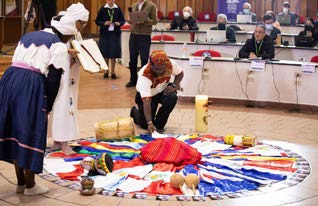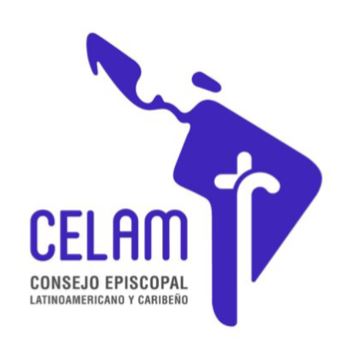The journey of the people of God
Publish date 11-08-2022
In full synodal spirit, the Ecclesial Assembly of Latin America has managed to give a voice to all members of the church.

In this time, in which the synodal path of the Italian Church is intertwined with the Synod of the universal Church, it is good to take a look at the experiences that come from the rest of the world. Of particular importance is the Ecclesial Assembly of Latin America which, in the last week of November, saw about a hundred delegates gathered at the feet of the Virgin of Guadalupe, at the Casa Lago just outside Mexico City.
The event, promoted by the Latin American Episcopal Council (celam), was completely unprecedented: it was not an episcopal conference like the five previous ones organized by celam. The entire people of God met, represented by a thousand delegates: 20% bishops, 20% priests, another 20% exponents of religious life, 40% are lay people.
For a week, everyone - alternating moments of common discernment, reflection in small groups, prayer and celebration - tried to give new impetus to the process started by the Fifth Conference fourteen years ago.
"Aparecida - said Monsignor Miguel Cabrejos, president of celam in the opening message - is the ecclesial experience that inspires and accompanies this Assembly". The journey began in May two years ago, when, after careful discernment, the celam submitted to Pope Francis the request to convene a Sixth Episcopate Conference.
It was the Pontiff who suggested returning to Aparecida in another way, to grasp and relaunch his prophetic ideas. Starting, precisely, from the exhortation contained in point 548 of the Final Document: "We cannot remain calm in our temples, in passive waiting, but it is urgent to go in all directions to proclaim that evil and death do not have the last word. ". An urgency, perhaps, even stronger now: the path of the Assembly is intertwined with the pandemic that has raged with particular cruelty on Latin America. Covid has devoured millions of lives, the record on the planet, and destroyed 8% of GDP, plunging over 40 million people into poverty. "The hardest crisis of our generation," Monsignor Cabrejos defined it, in the midst of which the Church has taken an attitude of discernment.
The listening and preparation process, from April to August, involved over 70 thousand people in a community journey, summarized in the preparatory document. In the wake of their reflections, the expression developed that alternated the participation of delegates in presence and connected via the internet, united by the desire to meet, to walk together.
This is the pastoral conversion that makes the Church ever more evangelizing and missionary. And, therefore, synodal. Since synodality - underlined Cardinal Marc Ouellet, prefect of the Congregation of Bishops and president of the Pontifical Commission for Latin America - "must always be understood in an outgoing dynamism" towards the other. And the other.
Women - one third of the total - were the great protagonists of the Assembly. The voice of the religious and laity rang out prophetically and strongly in moments of common reflection, discernment in groups, prayer, witness, liturgy. By giving a tangible answer to the question of the "place" of women in the Church. Sister Liliana Franco, president of the Conference of Latin American Religious (CLAR) explained this: "We have seen it in these days, through the concrete witness of the sisters: the place of women is spirituality, the place of women is theological elaboration, the woman's place is the frontier where no one else wants to be ». The crossroads populated by Central American migrants fleeing violence and forced into an equally ferocious exodus, to which the Mexican nun Dolores Palencia is dedicated. Or by people with sexual diversity, often rejected by their families themselves, welcomed by the Paraguayan Miriam González, of the Community of Christian Life (cvx). Victims of abuse, in society and in the Church, accompanied by the Costa Rican Lisandra Cháves and the Brazilian nun Maria Inés Veira. Discarded indigenous and Afro-descendant peoples, alongside which walk the Brazilian Laura Vicuña, the Peruvian by adoption Birgit Weiler and the Honduran Maria Suyapa. Their cry resounded in the priority "horizons of work" listed in the final message: promotion of the leadership of young people, women, the laity, accompaniment of the victims of all forms of exclusion and violence, defense of life, renewal, construction of integral ecology , fight against clericalism, renewal of formation in seminaries.
A job to do together. The Ecclesial Assembly, therefore, took the form of a general rehearsal of synodality. In this sense, Latin America becomes, once again, a living source of creative innovations for the universal Church
Lucia Capuzzi
NP Aprile 2022

 CELAM - Latin American Episcopal Council - was born in 1955, in Rio de Janeiro, with the approval of Pope Pius XII, during a first meeting of the Latin American bishops.
It brings together the bishops of Latin America and the Caribbean.
A prominent figure among these was Dom Helder Camara, who was its vice president and then president from 1958 to 1965.
The current president is Archbishop Héctor Miguel Cabrejos Vidarte, O.F.M., Archbishop of Trujillo.
The Council is based in Bogota, Colombia.
The first five General Conferences organized by CELAM:
- RIO DE JANEIRO (Brazil), 25 July-4 August 1955
- MEDELLIN (Colombia), 28 August-6 September 1968, inaugurated by Paul VI
- PUEBLA (Mexico), January 27-February 13, 1979, with the presence of John Paul II
- SANTO DOMINGO (Dominican Republic), 12-28 October 1992
- APARECIDA (Brazil), 13-31 May 2007, with the presence of Benedict XVI
THE LOGO blends the elements that represent the essence of Celam: the pastoral, which represents the episcopate and the vocation of the bishops; the cross, which symbolizes Christianity and the evangelizing work of the Church; the map of Latin America and the Caribbean, which indicates the missionary space of Celam.
CELAM - Latin American Episcopal Council - was born in 1955, in Rio de Janeiro, with the approval of Pope Pius XII, during a first meeting of the Latin American bishops.
It brings together the bishops of Latin America and the Caribbean.
A prominent figure among these was Dom Helder Camara, who was its vice president and then president from 1958 to 1965.
The current president is Archbishop Héctor Miguel Cabrejos Vidarte, O.F.M., Archbishop of Trujillo.
The Council is based in Bogota, Colombia.
The first five General Conferences organized by CELAM:
- RIO DE JANEIRO (Brazil), 25 July-4 August 1955
- MEDELLIN (Colombia), 28 August-6 September 1968, inaugurated by Paul VI
- PUEBLA (Mexico), January 27-February 13, 1979, with the presence of John Paul II
- SANTO DOMINGO (Dominican Republic), 12-28 October 1992
- APARECIDA (Brazil), 13-31 May 2007, with the presence of Benedict XVI
THE LOGO blends the elements that represent the essence of Celam: the pastoral, which represents the episcopate and the vocation of the bishops; the cross, which symbolizes Christianity and the evangelizing work of the Church; the map of Latin America and the Caribbean, which indicates the missionary space of Celam.







